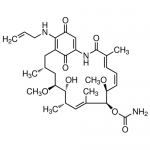| Product Name | 17-AAG |
| Description |
Hsp90 inhibitor |
| Purity | >99% (HPLC); NMR (Conforms) |
| CAS No. | 75747-14-7 |
| Molecular Formula | C31H43N3O8 |
| Molecular Weight | 585.7 |
| Field of Use | Not for use in humans. Not for use in diagnostics or therapeutics. For in vitro research use only. |
Properties
| Storage Temperature | -20ºC |
| Shipping Temperature | Shipped Ambient |
| Product Type | Inhibitor |
| Solubility | Soluble in DMSO (>50 mg/ml) or ethanol (5 mg/ml) |
| Source | Synthetic |
| Appearance | Red to dark red powder |
| SMILES | C[C@H]1C[C@@H]([C@@H]([C@H](/C=C(/[C@@H]([C@H](/C=CC=C(C(=O)NC2=CC(=O)C(=C(C1)C2=O)NCC=C)/C)OC)OC(=O)N)C)C)O)OC |
| InChI | InChI=1S/C31H43N3O8/c1-8-12-33-26-21-13-17(2)14-25(41-7)27(36)19(4)15-20(5)29(42-31(32)39)24(40-6)11-9-10-18(3)30 |
| InChIKey | AYUNIORJHRXIBJ-TXHRRWQRSA-N |
| Safety Phrases |
Classification: Caution: Substance not yet fully tested. Safety Phrases: S22 - Do not breathe dust S24/25 - Avoid contact with skin and eyes S36/37/39 - Wear suitable protective clothing, gloves and eye/face protection |
| Cite This Product | 17-AAG (StressMarq Biosciences Inc., Victoria BC CANADA, Catalog # SIH-100) |
Biological Description
| Alternative Names | 17-(Allylamino)-17-demethoxygeldanamycin, 17-(Allylamino)geldanamycin, 17-Demethoxy-17-allylamino geldanamycin, 17-AAG, CP 127374, Geldanamycin,17-demethoxy-17-(2-propenylamino)-, NSC 330507, Tanespimycin |
| Research Areas | Cancer, Heat Shock |
| PubChem ID | 6505803 |
| Scientific Background | 17-AAG (17-allylamino-17-demethoxygeldanamycin) is a potent inhibitor of heat shock protein 90 (HSP90), a molecular chaperone essential for the stability and function of numerous client proteins involved in cell signaling, survival, and protein homeostasis. Originally developed as an anticancer agent due to its selective affinity for tumor-derived HSP90, 17-AAG has gained attention in neuroscience for its ability to modulate protein degradation pathways. Notably, 17-AAG induces autophagy, a cellular clearance mechanism critical for the removal of misfolded proteins such as alpha-synuclein—an aggregation-prone protein implicated in Parkinson’s disease and other synucleinopathies. By promoting autophagic flux, 17-AAG may help restore proteostasis in neural cells and reduce neurotoxicity associated with protein aggregation. Its dual role in inhibiting Akt signaling and enhancing protein clearance positions 17-AAG as a promising candidate for therapeutic exploration in neurodegenerative disorders characterized by proteotoxic stress. |
| References |
1. Neckers L. (2002) Trends Mol Med. 84: S55-61. 2. Kamal A., et al.(2003) Nature. 425: 407. 3. Solit D.B., et al.(2003) Cancer Res. 63: 2139. 4. Vasilevskaya I.A., et al. (2003) Mol.Pharmacol. 65: 235. 5. Jia W., et al.(2003) Blood. 102: 1824. 6. Riedel M., Goldbaum O., Schwarz L., Schmitt S., Richter-Landsberg C. (2010) PLOS ONE. 5(1): e8753. https://doi.org/10.1371/journal.pone.0008753 |



Reviews
There are no reviews yet.